Not only is it ridiculously easy to grow Pineapple. Growing Pineapple plants is possible anywhere in the world. This is because the Pineapple plant is one of the few tropical fruits well suited to grow in pots, which means you can grow the Pineapple plants indoors. The best soils for producing Pineapple are uncompacted, well-aerated, and free-draining loam, sandy loam, and clay loam with no heavy soil or rock within a meter of the surface.

Good drainage is essential because poor drainage leads to a weak root system, making the plant more prone to root and heart rot diseases. The best soil for growing the Pineapple is a sandy loam, as the sand allows rapid leaching or water movement. Although Pineapples dislike waterlogged soil, they are drought-tolerant, but moisture is also needed for proper fruit growth. The Pineapple usually requires about 1 inch of water every week through rain or supplementary water. Let’s check out how to prepare the soil for Pineapple plants below.
How to prepare the soil for Pineapple Plants
Soil pH for Pineapple
The Pineapple requires a neutral to light acidic pH from 4.5 to 6.5, which you can test with a pH meter of soil. Soil that is too alkaline is necessary to treat sulfur to reduce pH. During winter, when growth slows, feed plants only once a month. The perfect soil for the Pineapple is a well-drained sandy loam with a high amount of organic matter. Soil should be friable for a depth of at least 2 feet and within the pH 4.5 to 6.5 range. pH increases the risk of a shortage of micro-elements over 6.5.
Preparation of soil for growing Pineapple on grounds
Grow the Pineapple plant in well-drained soil, which is light and aerated. The main factor affecting the growth of the Pineapple is that water comes out freely to prevent root rot. Since Pineapples do not have a wide root system, they grow best in sandy soil. Prepare a plantation site throughout the sun, sheltered from the prevailing breeze or wind.
In case you missed it: Growing Pineapple from Cuttings, Tops at Home
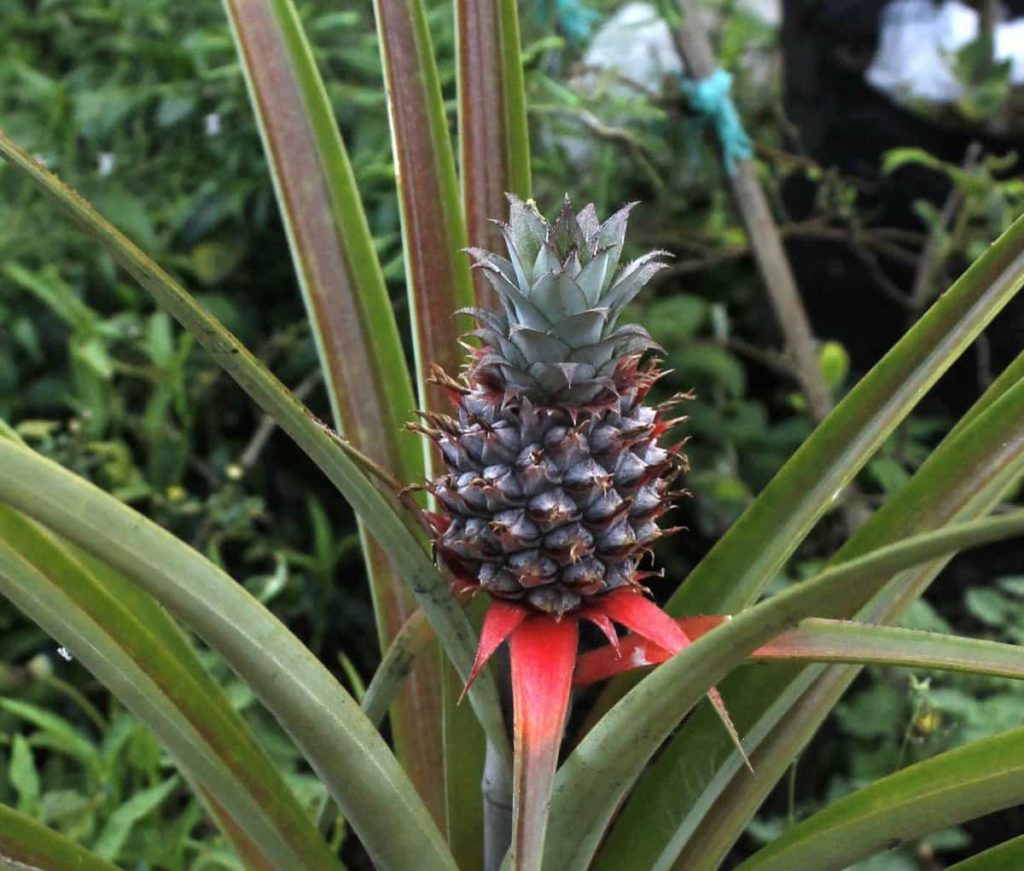
Prepare the amount of soil for the Pineapple plants by mixing a small amount of organic manure or compost in the top 12 inches of soil, ideally about a week before planting. Compost helps the soil to maintain water and essential nutrients, which help in the root development of the Pineapple plants. Set a black plastic ground cover on the planting bed. The ground cover of plastic will heat the soil, preserve the soil moisture and reflect the heat up to the plant.
After planting refill the trench, or hole with half the normal soil, and half-aged compost or commercial organic plantation mix. Make a small soil basin around the soil and plant base so that water can hold on to water at the time of water. After planting, water well, and fertilize with a high phosphorus liquid fertilizer. Applying thin natural mulch after planting, such as wood chips or bark, helps improve the nutritional quality of the topsoil.
Preparation of soil for growing Pineapple in pots
The Pineapple grown indoors also require a potting mix of light and sandy loam. You can use two parts of humus, 1 part of sand, and two parts of soil containing potting mix. Since drainage is essential for the growth of the Pineapple, the right container is also necessary.
After forming a 2-inch-deep hole in the center of the potting mix, insert the Pineapple core into this hole until the lower part of the crown is resting at the level of the mix. Tamp the mix around the core, and lock the pot and crown in a large, transparent plastic bag puffed with bags or with the help of several stakes, so it doesn’t touch the crown.
How to grow Pineapple in poor soil
Although the Pineapple can grow primarily on any soil type that allows enough air around the roots, the sandy loam soil with a loose soil structure and high humus (organic material) materials is best suited to the commercial Pineapple crop. An open structure soil is required so that enough air can circulate to the high oxygen-consuming roots.
In case you missed it: Growing Hydroponic Pineapples – A Full Guide
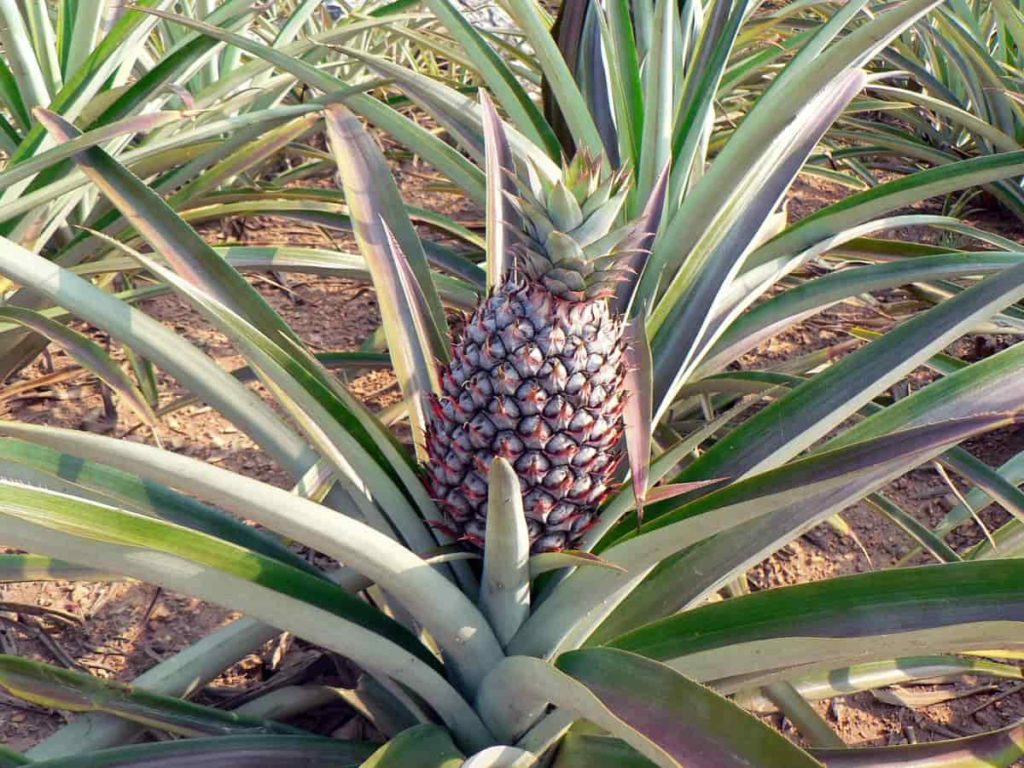
Closed and poorly structured heavy clay soil is not good for the Pineapple and should be avoided if possible. Deep ripping and excess organic manure before cultivation can greatly improve these heavier soils through drainage capacity and aeration if heavy clay soil use is necessary. Heavy loamy clay soil also needs additional surface drainage canals to remove abundant rain quickly. High humus content for the Pineapple crop is profitable.
Soil composting for Pineapple
Since the Pineapple can absorb nutrients through the aerial parts of the plant, there is no immediate dependence on the ground’s fertility. You can use poor fertility soil for the Pineapple crop. The gardeners should apply fertilizers such as organic manures in poor fertile lands. After planting, additional concentrated fertilizer will be required for maximum growth and quality of fruits. Even in high fertile lands, should remember that fertilization will be replaced by nutrients extracted by the crop if the fertility level and value of the soil and the land are maintained.
Humus is beneficial for optimum Pineapple growth on poor lands. You can use liquid fertilizers such as fish emulsion or seaweed extract. Create a dilute solution and use only a watering can to put it on the Pineapple plant and surrounding soil. If you use pelletized chicken manure, sprinkle it on the soil very close to the base of the Pineapple plant and make sure that a little fall into the bottom leaves.
Land preparation for Pineapple
The first step in producing Pineapple is to prepare the land for the Pineapple. Growers have to treat soil which involves the use of fertilizers, herbicides, and insecticides. Analyze soil samples six months before planting to determine fertilization and fumigation requirements. Then prepare beds, produce clean weeds, and burn more plants to death.
In case you missed it: Pineapple Gardening For Beginners, How To Start
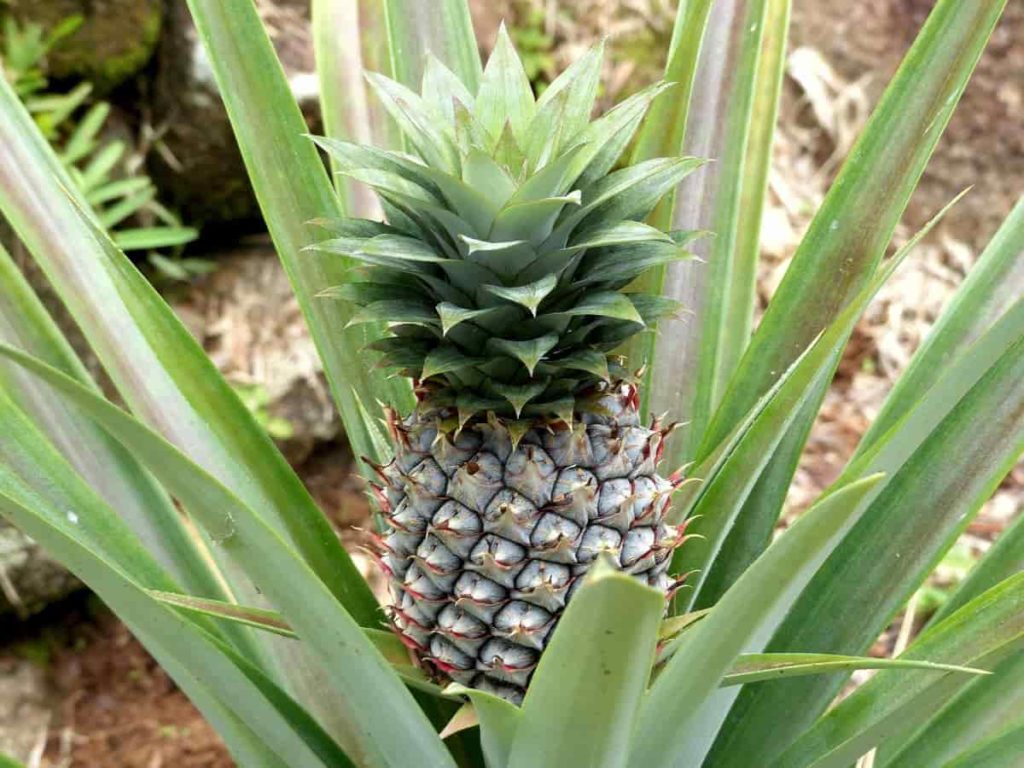
The last step in land preparation is to apply chemicals designed to eliminate any parasites that can already be found inside the soil, also known as nematicides. Remove trees, stumbles, and stones. Several times up to discs plows, and till the soil, to get a fine tilth, for effective plant root. Ridge soil to improve drainage, temperature, and air. The ground is dug up after plowing and then leveled. Then the trenches are dug. Each trench can be 15 to 30 cm deep and 90 centimeters wide.
Best soil mix for Pineapple
The acidic potting mix intended for Cactus, Palm, and Citrus plants should work for the Pineapples, as it usually has a rapid draining combination of peat, compost, sand, and perlite. If you like to make your mix, combine 1-part all-purpose potting soil, 1-part coarse sand, 1-part peat moss, and 1-part composted leaves.
Natural soil amendments for Pineapple
Soil modifications, such as lime and organic matter, indirectly affect plant growth by improving the physical or chemical state of the ground. Composted animal manure provides organic matter and improves soil structure while providing plant nutrients. Lime adjusts soil pH and delivers calcium; if from dolomite, it also provides magnesium.
The root growth of the Pineapple can vary dramatically between locations, so a site-specific understanding of root growth is important to determine whether plants will respond to the use of soil modifications consistently. Soil amendments can be broadcast immediately after the knockdown so you can incorporate them through tillage operations. Preplant fertilizers can be banded just below or adjacent to the plant line during bed formation to allow early prevention by developing roots.
Ideally, you should provide modifications and pre-plant fertilizers with all essential nutrients associated with side dressing or foliar fertilization while maintaining a good soil tilth, encouraging a healthy root system. For best results, nutrition management for the Pineapple should start with soil samples before the ground is prepared.
The Pineapple plant does not require much fertilization. You can use a diluted organic liquid fertilizer containing fish emulsion or seaweed. You can also sprinkle chicken manure near the base of the plant. To ensure that the Pineapples get the right nutrients, work in the compost in the soil before planting Pineapples. Nutrients feed the plant, and organic matter breaks down to feed your Pineapple.
What to do with soil when growing Pineapple
The best companion plants for the Pineapples are fruit trees, Sweet Potatoes, and nitrogen fixers such as cover crops, Pigeon Peas, and Vetch. The Pineapples grow best as an understory and benefit from protecting other plant canopies. Fruit trees help the Pineapples plants that shed the soil, hold the groundwater, break the compact soil and provide mulch (from their branches and leaves). In hot climates, the Pineapple grows very well in the partial shade of fruit trees.
In case you missed it: Best Fertilizer for Pineapple Plants: Homemade, Organic, Compost, Liquid, Natural, NPK, How and When to Apply
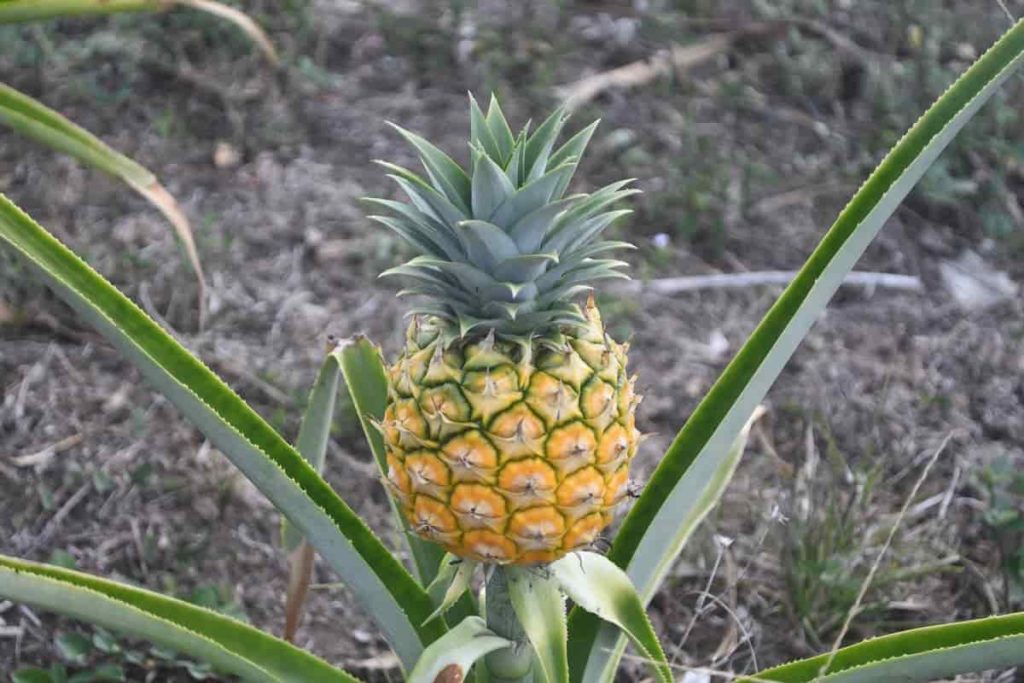
Fruit trees and other Pineapple companions include Ginger, Turmeric, Alliums, and cover crops. Sweet Potato is one of the best grounds covers out there, with amazing benefits providing the Pineapples such as increasing water retention, regulating soil temperature, and preventing soil erosion. Remember that Sweet Potato can compete with other vining plants or ground covers such as Nasturtium, Kiwi, and Jasmine if they are both close and grown in one place.
Many legumes like Clover, Peas, and Runner Beans (with some grass) are also known as cover crops because they are great pioneer plants for depleted soil. The covering crops improve soil health by slowing erosion, maintaining water, preventing weeds, and controlling pests and diseases. The Vetch is an interesting Legume as it is also a ground cover. Like covered crops, the growth of the Vetch is incredibly easy and highly beneficial in fixing soil nitrogen, which provides high-quality soil for the Pineapple.
Another leguminous plant, Pigeon Pea, is a wonderful choice for the companion plant of Pineapple. This tropical, protein-rich plant can reach between 3 and 12 feet long. And as a legume, it’s amazing in fixing nitrogen in the soil. Since Pigeon Peas are a midstory plant, they are ideal for shading soil around the Pineapple and regulating soil and root temperature. Ideally, plant Pigeon Peas on the west side of the Pineapple plants to shade their soil from the warm afternoon sun.
Like most, if not all, of these companions, Bananas are from the tropics. Banana plants provide an overstory layer to the Pineapple plants, which is great at providing them with partial shade during the scorching summer heat in the tropics. Generally, it is better to keep Palm trees on the west side of your Pineapple plants to provide partial shade from the warm afternoon sun.
Palm tree fronds also make a magnificent mulch for the plants of the Pineapple and attract beneficial predators like birds. Garlic, Onions, and Chives are all part of the same family; no wonder they are more powerful fragrances than most plants. This is due to their naturally occurring sulfur, which is very good at preventing insects, and its use as a natural antibacterial and fungicide.
In case you missed it: Custard Apple Gardening, Tips, Ideas, and Techniques
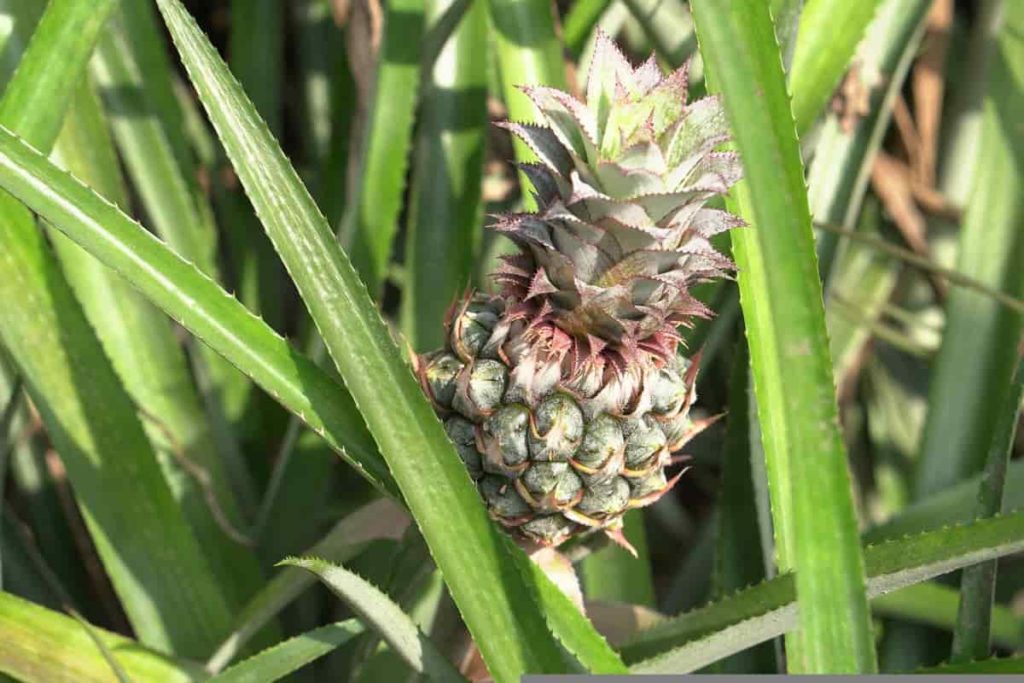
Ginger and Turmeric are native to the tropics. Since the tropics contain many bugs and insects, Ginger and Turmeric have adapted to prevent them; these plants are some of the best pest repellents in the garden. Kiwi benefits from the Pineapple by working as a vining plant and providing partial shade. It also attracts pollinators and beneficial predators.
What not to plant with the Pineapple
Although growing Pineapple can be difficult, it does not compete with many plants. Walnut and Eucalyptus trees, however, are known as allelopathic or release chemical inhibitors in the soil, which prevent other plants from growing. For this reason, keep the Pineapple plants away from these trees.
Conclusion
The Pineapple plant can be easily grown only by planting the tops in the soil. The top of the Pineapple grows in a bushy plant. If you get right the growing conditions, the fruit of the Pineapple plant flower, and the Pineapple eventually appear. The Pineapple can grow in pots inside the house, or if you live in a hot climate, it can grow out in your garden. Pineapple growing gives good returns with minimal maintenance. A successful Pineapple field requires good soil management and techniques.
- How to Grow Hibiscus from Flower
- Plantation Ideas for Home Decoration: A Beginners Guide
- Flower Garden Designs and Layouts for Beginners
- Planting and Spacing Techniques in Papaya: A Beginner’s Guide
- Growing Gold: Essential Techniques for Planting Pineapples
- How to Make Kalanchoe Plant Bushy: Home Remedies and Solutions
- 11 Reasons Why Your Gardenia is Not Blooming: Home Remedies and Solutions
- Eco Elegance: The Guide to Designing a Drought-Tolerant Landscape
- Gardening on a Slope: Strategies for Hillside Landscaping
- Nourish and Flourish: Top Organic Mulches for Thriving House Plants
- Everything You Want to Know about Indian Mogra Flower: Discover Uses and Growing
- Green Thumb Success: Expert Tips for Cultivating Greenhouse Pumpkins All Year Round
- Maximize Growth & Flavor: The Ultimate Guide to Companion Planting in Herb Gardens
- How to Control Rhododendron Problems Naturally: Home Remedies and Organic Ways to Fix Them
- Natural Magic: The Remarkable Benefits of Cinnamon for Plants
- Best Steps to Revive Dying Tulip with Natural and Organic Treatment
- 10 Reasons Why Your Angel Trumpet is Not Blooming: Remedies and Treatment
- How to Fix Periwinkle Leaf and Flower-Related Problems: Natural Remedies and Solutions
- How to Fix Zinnias Leaf and Flower Problems: Discover Natural and Home Remedies
- Organic Steps to Induce Lemon Tree Flowers: A Comprehensive Guide
- Bloom Booster: Crafting the Perfect Homemade Bougainvillea Fertilizer
- Optimizing Growth: A Guide to Applying NPK Fertilizer for Potted Plants
- 10 Best Homemade Fertilizers for Rubber Plant: DIY Recipes and Application Method
- How to Boost Female Pumpkin Flowers: Effective Steps for More Flowers and High Yields
- Transform Your Indoor Garden: Top Benefits of Pink Salt for Houseplants
- 10 Best Homemade Fertilizers for Peacock Plants (Calathea): Easy DIY Guide
- Unlock Blooms: 9 Reasons Why Your Potted Chrysanthemum is Not Blooming
- 8 Reasons Why Your Potted Hibiscus is Not Blooming: Fix it with Simple Solutions
- Unlock Blooms: 9 Key Reasons Your Potted Frangipani Won’t Flower
- 10 Reasons Why Is My Ice Plant Not Blooming: Remedies and Treatment
- 10 Reasons Why My Potted Hydrangea Not Blooming: Treatment and Remedies
- 10 Reasons Why is My Wisteria Not Blooming: Remedies and Treatment
- 10 Reasons Why is My Goldfish Plant Not Blooming: Remedies and Treatment
- Maximize Your Space: Ultimate Guide to Balcony Gardening with Grow Bags
- 10 Reasons Why Your Iris is Not Blooming: Remedies and Treatment
- 10 Reasons Why Your Anthurium Plant is Not Blooming: Treatment and Remedies